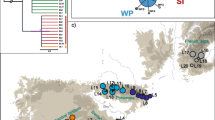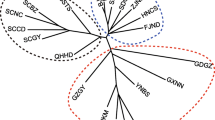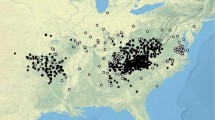Abstract
Alternating glacial and interglacial periods led to range shifts (contractions and expansions), persistence in distinct glacial refugia and extinction events in various temperate organisms. Today, the integrative analysis of molecular markers and spatial distribution models conducted for multiple taxa allows the detection of phylogeographical patterns, thus reconstructing major biogeographical events in their shared evolutionary history. In this study, the effects of past climate change on the evolutionary history of two sympatric moth species (Gnopharmia colchidaria s.l. and G. kasrunensis) and their host plants (Prunus scoparia and P. fenzliana) were inferred for the largely neglected biodiversity hot spot Iran. We complementarily analyzed the population structure of both moth species (187 specimens, based on COI) in congruence with batched species distribution models (SDMs) for all four taxa and for the times of the Last Glacial Maximum (21 ky BP), 6 ky BP and today. Coincidence of SDMs and the distribution of haplotype lineages indicated a shared refugium for the southwestern Zagros Mountains and potential species-specific refugial areas in the southern Caucasus and the Kope-Dagh Mountains. Both moth species experienced past population expansion.








Similar content being viewed by others
References
Ahmadzadeh, F., Carretero, M. A., Rödder, D., Harris, D. J., Freitas, S. N., Perera, A., et al. (2012). Inferring the effects of past climate fluctuations on the distribution pattern of Iranolacerta (Reptilia, Lacertidae): evidence from mitochondrial DNA and species distribution models. Zoologischer Anzeiger. doi:10.1016/j.jcz.2012.05.002.
Akhani, H. (1998). Plant biodiversity of Golestan National Park, Iran. Stapfia, 53, 1–411.
Akhani, H. (2004). A new spiny, cushion-like Euphorbia (Euphorbiaceae) from south-west Iran with special reference to the phytogeographic importance of local endemic species. Botanical Journal of the Linnean Society, 146, 107–121.
Akhani, H. (2007). Diversity, biogeography, and photosynthetic pathways of Argusia and Heliotropium (Boraginaceae) in South-West Asia with an analysis of phytogeographic units. Botanical Journal of Linnean Society, 155, 401–425.
Anderson, S. C. (1999). The Lizards of Iran. 442 pp. Ithaca (Society for the Study of Amphibians and Reptiles). ISBN 0-916984-49-4
Avise, J. C. (2000). Phylogeography: The history and formation of species. Cambridge: Harvard University Press.
Barve, N., Barve, V., Jiménez-Valverde, A., Lira-Noriega, A., Maher, S. P., Peterson, A. T., et al. (2011). The crucial role of the accessible area in ecological niche modeling and species distribution modeling. Ecological Modelling, 222(11), 1810–1819.
Beaumont, L. J., Hughes, L., & Poulsen, M. (2005). Predicting species distributions: use of climatic parameters in BIOCLIM and its impact on predictions of species’ current and future distributions. Ecological Modelling, 186, 250–269.
Braconnot, P., Otto-Bliesner, B., Harrison, S., Joussaume, S., Peterchmitt, J.-Y., Abe-Ouchi, A., et al. (2007). Results of PMIP2 coupled simulations of the Mid-Holocene and Last Glacial Maximum – Part 2: feedbacks with emphasis on the location of the ITCZ and mid- and high latitudes heat budget. Climate of the Past, 3(2), 279–296.
Browicz, K., & Zieliński, J. (1984). Chorology of trees and shrubs in south-west Asia and adjacent regions Vol. 4. Warszawa: Polish Scientific Publishers.
Busby, J. R. (1991). BIOCLIM - A bioclimatic analysis and prediction system. In C. R. Margules & M. P. Austin (Eds.), Nature conservation: Cost effective biological surveys and data analysis (pp. 64–68). Melbourne: CSIRO.
Chan, L. M. L., Brown, J. L., & Yoder, A. D. (2011). Integrating statistical genetic and geospatial methods brings new power to phylogeography. Molecular Phylogenetics and Evolution, 59(2), 523–537.
Clement, M., Posada, D., & Crandall, K. (2000). TCS: a computer program to estimate gene genealogies. Molecular Ecology, 9(10), 1657–1660.
Djamali, M. (2008). Palaeoenvironmental changes in Iran during the last two climatic cycles (vegetation-climate-anthropisation). PhD thesis in Universite Paul Cezanne (AIX-Marseille III).
Djamali, M., Akhani, H., Andrieu-Ponel, V., Braconnot, P., Brewer, S., de Beaulieu, J. L., et al. (2010). Indian Summer Monsoon variations could have affected the early-Holocene woodland expansion in the Near East. The Holocene, 20, 813–820.
Djamali, M., Biglari, F., Abdi, K., Andrieu-Ponel, V., de Beaulieu, J. L., Mashkour, M., et al. (2011). Pollen analysis of coprolites from a late PleistoceneeHolocene cave deposit (Wezmeh Cave, west Iran): insights into the late Pleistocene and late Holocene vegetation and flora of the central Zagros Mountains. Journal of Archaeological Science, 38, 3394–3401.
Djamali, M., Brewer, S., Breckle, S. W., & Jackson, S. T. (2012). Climatic determinism in phytogeographic regionalization: a test from the Irano-Turanian region, SW and Central Asia. Flora, 207, 237–249.
Elith, J., & Leathwick, J. R. (2009). Species distribution models: ecological explanation and prediction across space and time. Annual Reviews in Ecology, Evolution and Systematics, 40, 677–697.
Elith, J., Graham, C. H., Anderson, R. P., Dudík, M., Ferrier, S., Guisan, A., et al. (2006). Novel methods improve prediction of species’ distributions from occurrence data. Ecography, 29(2), 129–151.
Elith, J., Kearney, M., & Phillips, S. (2010). The art of modelling range-shifting species. Methods in Ecology and Evolution, 1(4), 330–342.
Elith, J., Phillips, S. J., & Hastie, T. (2011). A statistical explanation of MaxEnt for ecologists. Diversity and Distributions, 17(1), 43–57.
El-Moslimany, A. P. (1986). Ecology and late-Quaternary history of the Kurdo-Zagrosian oak forest near Lake Zeribar, western Iran. Vegetatio, 68, 55–63.
Evans, M. I. (1994) Important bird areas in the Middle East. Bird Life International Publication. 410 pp.
Excoffier, L., & Lischer, H. E. L. (2010). Arlequin ver. 3.5: a new series of programs to perform population genetics analyses under Linux and Windows. Molecular Ecology Resources, 10, 564–567.
Fu, Y. (1997). Statistical tests of neutrality of mutations against population growth, hitchhiking and background selection. Genetics, 147, 915–925.
Guisan, A., & Zimmermann, N. (2000). Predictive habitat distribution models in ecology. Ecological Modelling, 135, 147–186.
Habel, J. C., & Assmann, T. (2009). Relict species: Phylogeography and conservation biology. Berlin: Springer.
Hall, T. A. (1999). BioEdit: a user-friendly biological sequence alignment editor and analysis program for Windows 95/98/NT. Nucleic Acids Symposium Series, 41, 95–98.
Harpending, H. C. (1994). Signature of ancient population growth in a lowresolution mitochondrial DNA mismatch distribution. Human Biology, 66, 591–600.
Hartl, D. L., & Clark, A. G. (1997). Principles of population genetics (3rd ed.). Sunderland: Sinauer Associates Inc.
Hewitt, G. M. (1996). Some genetic consequences of ice ages, and their role in divergence and speciation. Biological Journal of the Linnean Society, 58, 247–276.
Hewitt, G. M. (2000). The genetic legacy of the Quaternary ice ages. Nature, 405, 907–913.
Hewitt, G. M. (2001). Speciation, hybrid zones and phylogeography — or seeing genes in space and time. Molecular Ecology, 10, 537–549.
Hijmans, R. J., Cameron, S. E., Parra, J. L., Jones, P. G., & Jarvis, A. (2005). Very high resolution interpolated climate surfaces for global land areas. International Journal of Climatology, 25, 1965–1978.
Hillman, G. (1996). Late Pleistocene changes in wild plant-foods available to hunter-gatherers of the northern Fertile Crescent: Possible preludes to cereal cultivation. In D. R. Harris (Ed.), The origins and spread of agriculture and pastoralism in Eurasia (pp. 159–203). UCL Press.
Ivanova, N. V., deWaard, J. R., & Hebert, P. D. N. (2006). An inexpensive, automation-friendly protocol for recovering high-quality DNA. Molecular Ecology Notes, 6, 998–1002.
Jiménez-Valverde, A., Peterson, A. T., Soberón, J., Overton, J. M., Aragón, P., & Lobo, J. M. (2011). Use of niche models in invasive species risk assessments. Biological Invasions, 13(12), 2785–2797.
Katoh, K., Misawa, K., Kuma, K., & Miyata, T. (2002). MAFFT: a novel method for rapid multiple sequence alignment based on fast Fourier transform. Nucleic Acids Res., 30, 3059–3066.
Kelts, K., & Shahrabi, M. (1986). Holocene sedimentology of hypersaline Lake Urmia, northwestern Iran. Palaeogeography, Palaeoclimatology, Palaeoecology, 54, 105–130.
Kiehl, J. T., & Gent, P. R. (2004). The community climate system model, version 2. Journal of Climate, 17, 1666–1669.
Kryzhanovsky, O. L., & Atamuradov, K. I. (1994). Zoogeography of Coleoptera in Turkmenistan. In V. Fet (Ed.), Biogeography and ecology of Turkmenistan (pp. 403–418). Boston: Dordrecht. 616 p.
Kuhle, M. (2008). The Pleistocene Glaciation (LGP and pre-LGP, pre-LGM) of SE Iranian mountains Exemplified by the Kuh-i-Jupar, Kuh-i-Lalezar and Kuh-i-Hezar Massifs in the Zagros. Polarforschung, 77, 71–88.
Kunte, K. (2008). Competition and species diversity: removal of dominant species increases diversity in Costa Rican butterfly communities. Oikos, 117, 69–76.
Libradi, P., & Rozas, J. (2009). DnaSP v5: a software for comprehensive analysis of DNA polymorphism data. Bioinformatics, 25, 1451–1452.
Naumann, C. M. (1987). Distribution patterns of Zygaena moths in the Near and Middle East. In F. Krupp, W. Schneider & R. Kinzelbach (Eds.), Proceedings of the Symposium on the Fauna and Zoogeography of the Middle East: Beihefte zum TAVO A, 28, 200-212.
Nei, M., & Miller, S. C. (1990). A simple method for estimating average number of nucleotide substitutions within and between populations from restriction data. Genetics, 125, 873–879.
Noroozi, J., Akhani, H., & Breckle, S. W. (2008). Biodiversity and phytogeography of the alpine flora of Iran. Biodiversity and Conservation, 17(3), 493–521.
Peterson, A. T., & Nyári, Á. S. (2007). Ecological niche conservatism and pleistocene refugia in the Thrush-like Mourner, Shiffornis sp., in the Neotropics. Evolution, 62, 173–183.
Petit, R. J., Aguinagalde, I., de Beaulieu, J.-L., Bittkau, C., Brewer, S., Cheddadi, R., et al. (2003). Glacial refugia: hotspots but not melting pots of genetic diversity. Science, 300, 1563–1565.
Phillips, S. J., & Dudík, M. (2008). Modeling of species distributions with Maxent: new extensions and a comprehensive evaluation. Ecography, 31, 161–175.
Phillips, S. J., Anderson, R. P., & Schapire, R. E. (2006). Maximum entropy modeling of species geographic distributions. Ecological Modelling, 190, 231–259.
Phillips, S. J., Dudík, M., Elith, J., Graham, C. H., Lehmann, A., Leathwick, J., et al. (2009). Sample selection bias and presence-only distribution models: implications for background and pseudo-absence data. Ecological Applications, 19(1), 181–197.
Proven, J., & Bennett K. D. (2008). Phylogeographic insights into cryptic glacial refugia, Cell press, doi:101016/j.tree.2008.6.10.
Rajaei Sh, H. (2010). Life history of Gnopharmia kasrunensis Wehrli, 1939 and G. colchidaria Lederer, 1870 (Geometridae, Ennominae) and their distribution in Iran, with first host-plant records for the genus. Bonn Zoological Bulletin, 57(1), 65–73.
Rajaei Sh, H., Stüning, D., & Trusch, R. (2012). Taxonomic revision and zoogeographical patterns of the species of Gnopharmia Staudinger, 1892 (Geometridae, Ennominae). Zootaxa, 3360, 1–52.
Rechinger, K. H., & Lack, W. (1991). Dipsacaceae. In K. H. Rechinger (Ed.), Flora Iranica 168. Graz: Akademische Druck-u.-Verlagsanstalt.
Roberts, N. (2002). Did prehistoric landscape management retard the post-glacial spread of woodland in Southwest Asia? Antiquity, 76, 1002–1010.
Roberts, D. R., & Hamann, A. (2012). Predicting potential climate change impacts with bioclimate envelope models: a palaeoecological perspective. Global Ecology and Biogeography, 21(2), 121–133.
Roberts, N., & Wright Jr., H. E. (1993). Vegetational, lake-level and climatic history of the Near East and Southwest Asia. In H. E. Wright Jr., J. E. Kutzbach, T. Webb III, W. F. Ruddiman, F. A. Street-Perrott, & P. J. Bartlein (Eds.), Global climates since the last glacial maximum (pp. 194–220). University of Minnesota Press.
Rocchini, D., Hortal, J., Lengyel, S., Lobo, J. M., Jimenez-Valverde, A., Ricotta, C., et al. (2011). Accounting for uncertainty when mapping species distributions: the need for maps of ignorance. Progress in Physical Geography, 35(2), 211–226.
Schweiger, O., Settele, J., Kudrna, O., Klotz, S., & Kühn, I. (2008). Climate change can cause spatial mismatch of trophically interacting species. Ecology, 89(12), 3472–3479.
Seddon, J. M., Santucci, F., Reeve, N., & Hewitt, G. M. (2002). Caucasus Moun-tains divide postulated postglacial colonization routes in the white-breasted hedgehog, Erinaceus concolor. Journal of Evolutionary Biology, 15, 463–467.
Stevens, L. R., Wright, H. E., Jr., & Ito, E. (2001). Proposed changes in seasonality of climate during the Late-glacial and Holocene at Lake Zeribar, Iran. The Holocene, 11, 747–756.
Stewart, J. R., Lister, A. M., Barnes, I., & Dalén, L. (2010). Refugia revisited: individualistic responses of species in space and time. Proceedings of the Royal Society B, 277(1682), 661–671.
Svenning, J. C., Fløjgaard, C., Marske, K. A., Nógues-Bravo, D., & Normand, S. (2011). Applications of species distribution modeling to paleobiology. Quaternary Science Reviews, 30(21–22), 2930–2947.
Swets, J. A. (1988). Measuring the accuracy of diagnostic systems. Science, 240, 1285–1293.
Tajima, F. (1989). Statistical method for testing the neutral mutation hypothesis by DNA polymorphism. Genetics, 123, 585–595.
Templeton, A. R. (1998). Nested clade analyses of phylogeographic data: testing hypotheses about gene flow and population history. Molecular Ecology, 7, 381–397.
van Zeist, W., & Bottema, S. (1977). Palynological investigations in western Iran. Palaeohistoria, 19, 19–85.
van Zeist, W., & Bottema, S. (1991). Late quaternary vegetation of the near East. Dr Ludwig Reichert Verlag.
van Zeist, W., & Wright, H. E. (1963). Preliminary pollen studies at Lake Zeribar, Zagros Mountains, southwestern Iran. Science, 140, 65–67.
Volodicheva, N. (2002). The Caucasus. In M. Shahgedanova (Ed.), The physical geography of Northern Eurasia (pp. 350–376). UK: Oxford University Press.
Waltari, E., Hijmans, R. J., Peterson, A. T., Nyári, A. S., Perkins, S. L., & Guralnick, R. P. (2007). Locating Pleistocene refugia: comparing phylogeographic and ecological niche model predictions. PLoS ONE, 7(e563), 1–11.
Weir, J. T., & Schluter, D. (2004). Ice sheets promote speciation in boreal birds. Proceedings of the Royal Society of London, Biological Science, 271, 1881–1887.
White, F., & Léonard, J. (1991). Phytogeographical links between Africa and Southwest Asia. Fl Veg Mundi, 9, 229–246.
Wright, H. E. (1961). Pleistocene glaciation in Kurdistan. Eiszeitalter und Gegenwart, 12, 131–164.
Zohary, M. (1973). Geobotanical foundations of the Middle East (Vol. 2). Stuttgart: Fischer.
Acknowledgments
We thank Thomas Schmitt (Trier, Germany) for his advice on the preliminary steps of this project. Special thanks go to Morteza Djamali (France) for sharing his knowledge on the paleoecology and climatology of Iran. Paul Hebert (Biodiversity Institute of Ontario, Guelph, Canada) and Axel Hausmann supported the main part of DNA sequencing in the framework of the International Barcode of Life (iBOL) project that is run by Genome Canada, the Ontario Ministry of Research and Innovation and Natural Science and Engineering Research Council of Canada (NSERC). The second part of DNA sequencing was provided by the ZMB (Center of Molecular Biodiversity Research, ZFMK, Bonn).
Author information
Authors and Affiliations
Corresponding author
Electronic supplementary material
Below is the link to the electronic supplementary material.
Table 2 and 3
(DOC 470 kb)
Rights and permissions
About this article
Cite this article
Rajaei Sh, H., Rödder, D., Weigand, A.M. et al. Quaternary refugia in southwestern Iran: insights from two sympatric moth species (Insecta, Lepidoptera). Org Divers Evol 13, 409–423 (2013). https://doi.org/10.1007/s13127-013-0126-6
Received:
Accepted:
Published:
Issue Date:
DOI: https://doi.org/10.1007/s13127-013-0126-6




